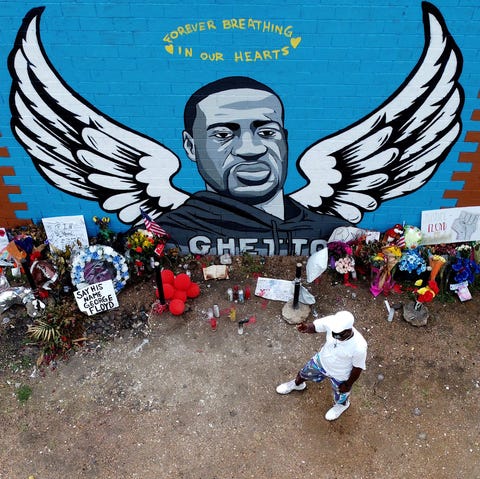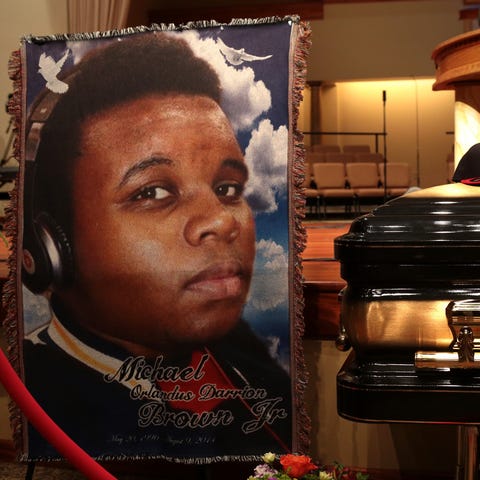On May 25, 17-year-old Darnella Frazier was walking to the store with her 9-year-old cousin when she saw a man lying facedown on the sidewalk, a cop’s knee on his neck.
As most of the world now knows, for 10 excruciating minutes and nine seconds, she recorded the murder of George Floyd on her iPhone, posting the video to Facebook the next day. Later, she said she filmed the shockingly brutal incident—which was so universally repugnant it quickly sparked racial protests all over the world—because she didn’t think anyone would believe her.
“How do we educate the populace about the problem of police violence, specifically against Black communities?” Tara Pixley, a visual journalist and assistant professor at Loyola Marymount University, says later when we speak by phone. “How do we convince them? They’ll only believe it if they see it.” Frazier may be one of the most well-known recent examples of regular citizen–turned–cell-phone justice crusaders. But she was far from the first. Between 2009 and 2020, incidents of systemic racism and police brutality caught on camera mounted steadily. In 2009, Karina Vargas used her digital camera to record the killing of Oscar Grant, who was shot in the back by rapid transit police while restrained and lying facedown on the ground at Fruitvale Station in Oakland, California. Violent police behavior that led to the deaths of Eric Garner, Tamir Rice, Walter Scott, Freddie Gray, and Alton Sterling was all caught on camera. Diamond Reynolds livestreamed the murder of her boyfriend, Philando Castile, from the passenger seat of his car. Sandra Bland filmed her own arrest in 2015. She was found dead, hanging in her jail cell, three days later. The video of her arrest was only recently released.

But now, in the wake of Floyd’s death, racist abuse at the hands of everyone from cops to lady dog-walkers has been so assiduously documented and shared that its systemic nature, long denied, has become undeniable. In grocery stores, parks, high schools, bike paths—wherever racism rears its head, there is a cell phone camera on hand to capture the event and a social media army ready to mobilize.
In Maryland, a man on a bike stopped to rip the Black Lives Matter flyers out of a little girl’s hands. In Arizona, a woman at a gas station convenience store yelled “You’re going back to Mexico” at a Latina woman and got slapped. In Georgia, two students were expelled from high school after posting a racist video on TikTok. A 46-year-old white woman in California pepper-sprayed a group of teenage protesters. One of them filmed the incident, got a shot of her license plate, and posted it with the directive, “TikTok do your thing.” (The woman was later arrested.)
“A picture is worth a thousand words,” says T. Greg Doucette. “A video's worth a thousand pictures."
“All the videos of Karens and the whole meme-ifying of this situation is just a way for Black and brown people in this country to deal with this truly tragic daily experience of implicit and explicit racism,” Pixley says. “Turning tragedy into humor is a survival tactic, and it’s something that Black Americans have had to do for centuries.” On social media, she says, Black and brown communities feel empowered to speak out against racism and educate people in a way that is, for some, more palatable. “People will accept the truth if it’s delivered in a humorous way, far more than they’ll accept it if it makes them feel bad.”
Six years ago, it was not a given that such things would go viral or result in justice. In 2014, for instance, Kianga Mwamba was in her car on her way to pick up food when she witnessed a violent arrest on the side of the street. “I saw a guy on the ground,” says Mwamba, whose father was a Maryland Capitol police officer. “They were kicking and stomping him, and he was in handcuffs, so I started recording,” she says. When officers saw her filming, they told Mwamba to pull over, but she couldn’t because there were cars to the right of her. “The officer jumped on my car and started pulling me out. Then they Tased me and I was arrested.”
When Mwamba asked why she was being arrested, an officer called her a “dumb bitch” and accused her of trying to hit one of his fellow agents with her car. She was charged with trying to run over an officer with a vehicle and spent the night in jail. When her phone was returned to her, she saw that the video had been deleted. Had it not been automatically backed up to Google, she would have had no way to prove that the report was false. When Mwamba produced the video of her arrest, the charges against her were dropped. “It was evident that I did not hit anybody, because my car never moved,” she says. She filed a lawsuit against the Baltimore police, and eventually reached a settlement. In recent months, the change in public awareness of police violence against Black and brown people—and the everyday racism that enables it—has been dramatic. Social media has galvanized its audience, finally cracking through the wall of denial that kept these incidents at least partly obscured. On May 29, three days after Frazier posted her video, a 39-year-old criminal defense and First Amendment attorney in Durham, North Carolina, named T. Greg Doucette started compiling videos of police brutality in a Twitter thread. Doucette, who describes himself as conservative but not Republican (not anymore), has been sharing videos of police brutality on social media since 2007, but says he was frustrated at how the furor would die down between incidents: “When you’re just doing it once every couple of days, no one really sees that it’s a systemic problem. They say, ‘That’s just one bad apple.’ ”
So when the Floyd protests began, Doucette decided to wait until he had 10 videos before posting them. It only took two days. “I posted those 10 from cities all over the country,” he says. “Then other people started sending me stuff, so I started adding those in as well, and it ended up snowballing into a hot mess.” As of this writing, Doucette’s thread contained at least 775 videos documenting police violence at protests around the country since May 29.

“I think this is probably the most documented uprising that we’ve ever seen,” says Palika Makam, a 31-year-old media activist based in Brooklyn. Makam is the U.S. Senior Program Coordinator for Witness, a global organization that helps people use video to document human rights abuses. “Uprisings started really being documented around the Arab Spring, back in 2011 or 2012, and then obviously in Ferguson, Missouri. But the magnitude of what is happening right now [with people of all races] taking to the streets and using their cell phones in real time to hold officers accountable—we haven’t seen it on this scale before.”
Makam was born and raised in a South Asian immigrant community in Chicago. “That definitely informed my ideas of my place in the world as a brown woman living in America,” she says. She started out wanting to be a reporter, and founded a nonprofit in her early twenties that trained youth activists around the world in how to use video in their campaigns. “I worked in South Africa and Palestine,” she says. “Then around 2014, when [Michael] Brown Jr. and Eric Garner were killed, I felt compelled to bring my work back home.”

After she returned to the U.S., Makam’s goal shifted to documenting abuses—and educating others on the most effective and safest ways to use social media to promote change. “People are inclined to whip out their phones when they see injustice,” she says. But these efforts often don’t lead to accountability, and can sometimes backfire, causing people to be targeted. In a recent post, Makam shared tips for filming police misconduct, from safety measures like obscuring identities and posting anonymously to knowing your rights, protecting your phone, automatically uploading footage to the cloud, and telling a story with your footage. “The first question to consider is: Am I putting myself in danger by posting this online?” she says. She also encourages people to think through issues of consent and traumatization. “Darnella Frazier hasn’t been retaliated against by police, but she’s been dealing with unwanted media attention and trolls. That’s a lot for anyone, especially a young Black woman who witnessed a traumatic event, to endure.”
It helps to have some sort of strategy for how you’re going to film your video and release it. When Walter Scott was killed by a North Charleston, South Carolina, police officer, a witness named Feiden Santana caught the entire thing on camera. “He was scared,” Makam says. “He wasn’t sure what to do.” Instead of posting the footage immediately, Santana reached out to an acquaintance online, who ultimately helped him get in touch with the lawyer representing Walter Scott’s family. The attorney then provided the tape to the New York Times. They published the video after the police report came out, which said that the officer killed Walter Scott out of self-defense when Scott tried to grab his Taser. “But the footage revealed that Walter Scott was running away from the officer when the officer shot him in the back eight times—and then took his Taser and planted it next to his dead body on the ground,” Makam says. When the video was released, the officer, Michael Slager, was arrested and charged with second-degree murder. The murder charge was dropped after Slager pleaded guilty to a federal charge of depriving Scott of his civil rights under color of law; he was later sentenced to 20 years in prison.
Doucette credits the torrent of video evidence of outrageous police conduct for the political momentum for reform we saw in June. “There’s an old saying: A picture is worth a thousand words,” he says. “What I tell people is that a video is worth a thousand pictures.” And he’s optimistic that those who used to be on the fence have had their eyes opened. “I hate to be ageist about it,” Doucette says, “but we’re seeing changes based on generation. The youngest folks, the ones on TikTok and Instagram and Snapchat, are getting this experience for the first time in their lives, and it’s going to encourage them to keep going to these protests and to stream them. Folks in their thirties to fifties are lobbying for actual police reform, contacting their elected officials. And as for the older folks? They’re the ones who vote the most, who give the most money to politicians and have the most influence. You’re going to see them really focus on changing who the elected officials are, getting reforms through legislation.” Still, he concludes, it’s a comprehensive effort that doesn’t end with documenting abuses. Rather, it starts there. “For better or worse, folks in the 18-to-24 age range don’t vote that often. But they’re the ones in the street, protesting and providing the raw information to the rest of us,” he says. “It’s on the rest of us to try to make sure that something good comes out of it.”
This story appears in the September 2020 issue.



